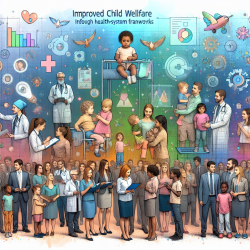Introduction
In the field of speech-language pathology, creating optimal outcomes for children is paramount. However, understanding the complex systems that influence these outcomes can be daunting. A recent study titled Investigating the citing communities around three leading health-system frameworks sheds light on how different health-system frameworks are utilized and can offer valuable insights for practitioners aiming to improve their skills and impact.
Understanding Health-System Frameworks
The study examines the citation communities around three influential health-system frameworks: the WHO's "building blocks," the Harvard-World Bank's "control knobs," and the framework by Murray and Frenk. Each framework has its own goals and applications, which are reflected in the communities that cite them.
- WHO's Building Blocks: This framework is widely used and focuses on the fundamental components of health systems, such as service delivery and health workforce. It's particularly popular in global health settings.
- Harvard-World Bank's Control Knobs: Aimed at system reform, this framework is frequently cited in discussions about health financing and policy-making processes.
- Murray and Frenk's Framework: Known for evaluating national health systems, this framework is often cited in studies focused on system performance and responsiveness.
Implications for Practitioners
For speech-language pathologists working in schools, understanding these frameworks can provide a broader context for the systems influencing child outcomes. Here are some actionable insights:
- Adopt a Systems Thinking Approach: By understanding how different components of health systems interact, practitioners can better navigate the complexities of school-based services.
- Focus on Evidence-Informed Practices: The study highlights the importance of using data and evidence to inform policy and practice, a crucial element in achieving better outcomes for children.
- Engage in Policy Discussions: Understanding the frameworks can empower practitioners to participate in policy discussions, advocating for changes that benefit child health and education.
Encouraging Further Research
The study also emphasizes the need for further research into how these frameworks are applied in different contexts. Practitioners are encouraged to explore these frameworks in their work settings, contributing to a broader understanding of their impact.
Conclusion
By delving into the citation communities around these health-system frameworks, practitioners can gain valuable insights into the systems that shape child outcomes. This understanding can lead to more informed decisions and ultimately, better outcomes for children.
To read the original research paper, please follow this link: Investigating the citing communities around three leading health-system frameworks.










